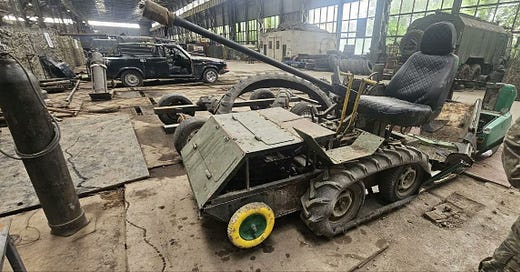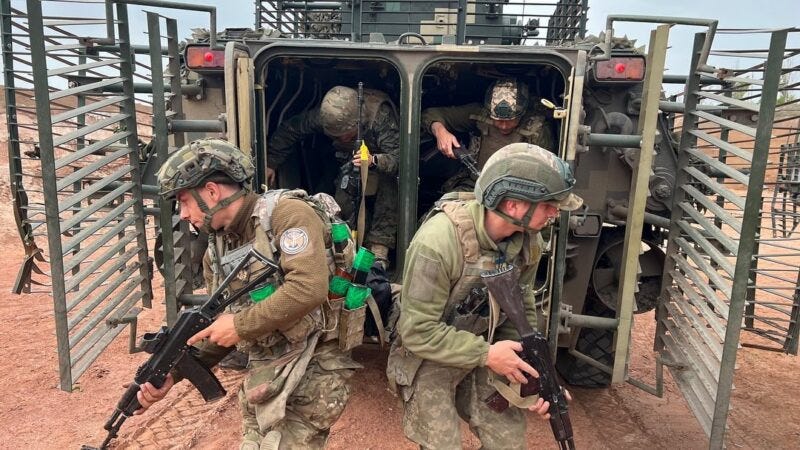In 39 months of hard fighting all along the 700-mile front line of Russia’s wider war on Ukraine, Russian forces have improvised a lot of very weird armored vehicles.
But the contraption that took shape in a Russian workshop somewhere, seemingly this week, is easily the weirdest yet—although it’s not clear the thing is meant to become an operational combat vehicle.
If so, it might represent the nadir of Russian de-mechanization—a process that began as Ukrainian forces blunted the initial Russian attack on Kyiv in February 2022, and has accelerated as the fighting has metastasized in eastern Ukraine and Russian losses in vehicles and other heavy equipment have surpassed 17,000.
Russian industry can’t build enough new armored vehicles to keep pace with losses. Even restoring thousands of old vehicles from long-term storage, the Russians can’t fully replace combat losses.
Which is why Russian regiments and brigades in Ukraine increasingly ride into combat on or in civilian vehicles: old GAZ-69 trucks, compact cars with their doors removed, golf carts, motorcycles and even electric scooters and unicycles. Unarmored civilian rides are better than no rides.
But even civilian cars, trucks and scooters are constrained by supply. That might explain why some insane—or enterprising, or both—Russian engineers cobbled together what appears to be an autocannon-armed fire-support vehicle based on some kind of six-wheel chassis, converted for treads, which might include major subassemblies from a tractor or lawnmower.
Again, it’s not at all clear that the thing is meant to be a deployable combat vehicle. It might even be a joke: some Russians riffing on the expectation that they’ll ride practically anything into battle.
Either way, it’s worth scrutiny, and mockery, as what was once the world’s leading mechanized army devolves in the unforgiving conditions in Ukraine, where tiny drones are everywhere all the time and every attack meets a wall of mines, artillery and razor wire.
Incredibly, however, the vehicular self-parody isn’t indicative of a wider failure on the part of the Kremlin. Its doctrine in Ukraine is actually working, for now—even as its troops potentially deploy a cannon-armed lawnmower.
It’s normal, as the wider war grinds toward its 40th month, for the Russians to send under-trained, unprotected troops on “reconnaissance-by-force” missions in the early hours of an offensive.
At the risk of repeating myself, I’ll cite a recent study from the Royal United Services Institute in London. Recon troops “are ordered to advance towards where they assess Ukrainian positions to be, conducting reconnaissance by drawing fire,” RUSI analysts Nick Reynolds and Jack Watling explained.
“If the group encounters resistance, Russian commanders assess where they believe the best lines of approach are, and in particular, where the boundaries between defensive units lie,” Reynolds and Watling added. “If Ukrainian positions are positively identified, sections are persistently sent forward to attack positions.”
So when Russians attack on motorcycles, scooter or—yes—lawnmowers, they’re usually just the first wave of a possible wider assault. Subsequent waves don’t bother to deploy their heavier, pricier and rarer armored vehicles unless the first wave, usually traveling in much lighter and cheaper vehicles, succeeds.
It’s an approach to mechanized warfare that costs Russia a thousand or more casualties a day, but still occasionally results in breakthroughs. As long as the Kremlin can recruit more troops every month than it buries or puts in the hospital, it can keep attacking—and keep incrementally gaining ground.
And so far, the recruiting numbers are strong. The Kremlin inducts around 30,000 new troops per month, Gen. Christopher Cavoli, commander of U.S. Army forces in Europe, told U.S. lawmakers in April.
Yes, the front-line regiments lose a thousand people a day, killed and wounded—but many of the wounded eventually return to the front. So the Russian armed forces are actually recruiting slightly more people every month than they’re losing.
As a result, Cavoli said, the Russian force in Ukraine is slowly growing. It now numbers around 600,000 troops. That’s “the highest level over the course of the war and almost double the size of the initial invasion force,” Cavoli said.
Robust Russian recruitment comes down to two things: money and vibes. Record enlistments are “driven by high sign-on bonuses and speculation that the war will soon be over,” explained Janis Kluge, deputy head of the Eastern Europe and Eurasia Division at the German Institute for International and Security Affairs.
As long as the government money flows and Russians believe they’re winning, the Kremlin can continue feeding bodies into the hungry maw of Ukraine’s layered defenses. It doesn’t matter if they bodies are riding on a million-dollar armored vehicle … or a lawnmower.
Read more:
Ukraine Just Crushed a Rare Russian Armored Attack in Belgorod
The Ukrainian army’s elite 92nd Assault Brigade thwarted a potentially powerful Russian assault along Ukraine’s northern border with Russia last week—and knocked out an entire company of increasingly rare armored vehicles in the process.






